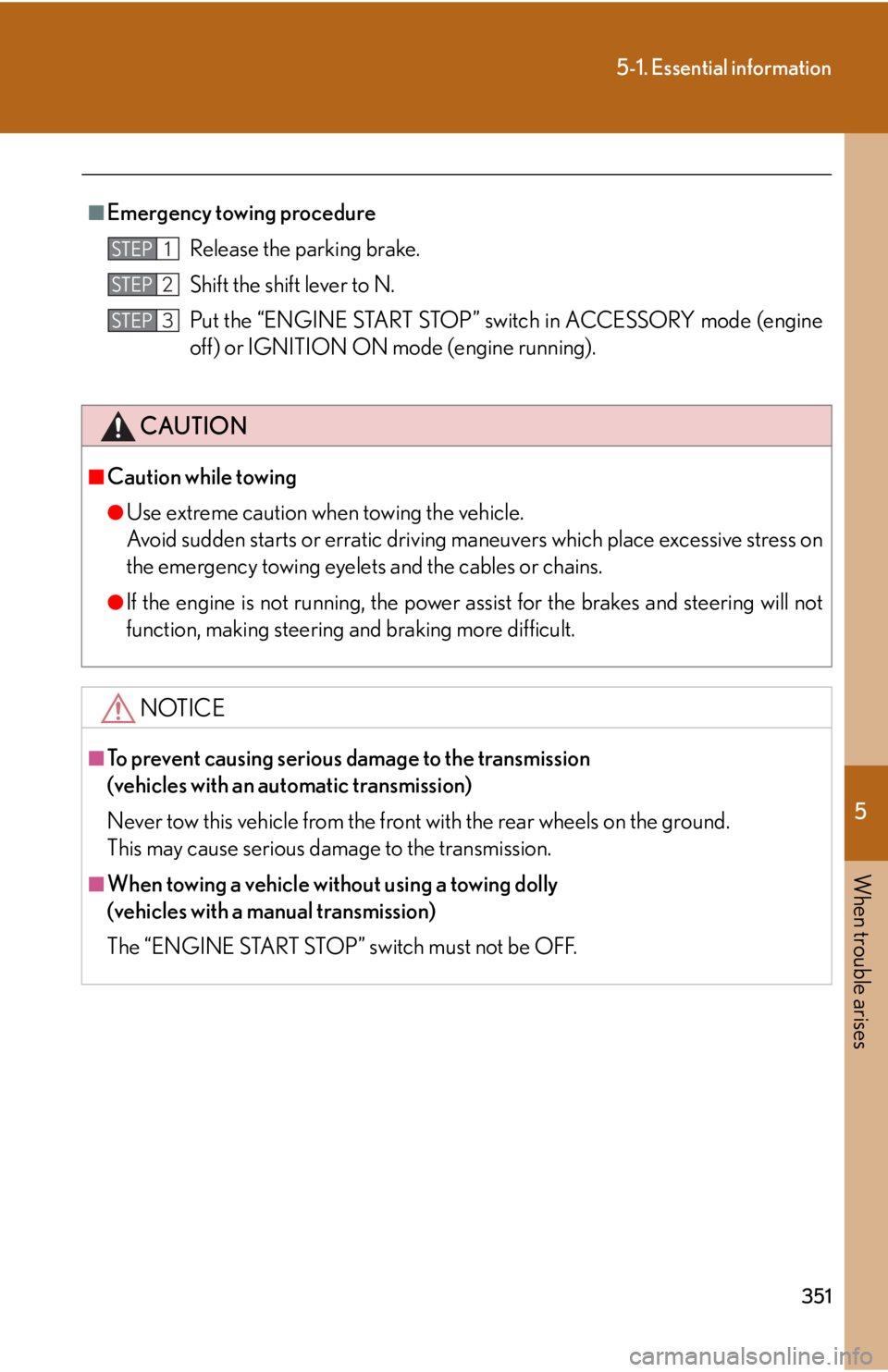emergency towing Lexus IS250 2008 Using the air conditioning system and defogger / LEXUS 2008 IS250 OWNER'S MANUAL (OM53699U)
[x] Cancel search | Manufacturer: LEXUS, Model Year: 2008, Model line: IS250, Model: Lexus IS250 2008Pages: 464, PDF Size: 6.61 MB
Page 350 of 464

350
5-1. Essential information
If your vehicle needs to be towed
Before towingThe following may indicate a problem with your transmission. Contact
your Lexus dealer before towing.
● The engine is running, but the vehicle will not move.
● The vehicle makes an abnormal sound.
Emergency towing
If a tow truck is not available, in an emergency your vehicle may be tem-
porarily towed using a cable or chain secured to the emergency towing
eyelet(s). This should only attempted on hard, surfaced roads for short
distances at low speeds.
A driver must be in the vehicle to s teer and operate the brakes. The vehi-
cle’s wheels, drive train, axles, steering and brakes must be in good condi-
tion.
Towing eyelets
If towing is necessary, we recommend having your vehicle towed by your
Lexus dealer or a commercial towing se rvice, using a lift-type truck or a flat
bed truck.
Use a safety chain system for all towi ng, and abide by all state/provincial
and local laws.
If towing from the rear, the vehicle’s front wheels and axles must be in good
condition. ( P. 3 5 4 )
If they are damaged, use a to wing dolly or flat bed truck.
Page 351 of 464

5
When trouble arises
351
5-1. Essential information
■Emergency towing procedureRelease the parking brake.
Shift the shift lever to N.
Put the “ENGINE START STOP” switch in ACCESSORY mode (engine
off) or IGNITION ON mode (engine running).
CAUTION
■Caution while towing
●Use extreme caution when towing the vehicle.
Avoid sudden starts or erratic driving maneuvers which place excessive stress on
the emergency towing eyelets and the cables or chains.
●If the engine is not running, the power assi st for the brakes and steering will not
function, making steering and braking more difficult.
NOTICE
■To prevent causing serious damage to the transmission
(vehicles with an automatic transmission)
Never tow this vehicle from the front with the rear wheels on the ground.
This may cause serious dama ge to the transmission.
■When towing a vehicle without using a towing dolly
(vehicles with a manual transmission)
The “ENGINE START STOP” switch must not be OFF.
STEP1
STEP2
STEP3
Page 352 of 464

352
5-1. Essential information
Installing towing eyeletsRemove the eyelet cover using a
flat head screwdriver.
To protect the bodywork, place a
rag between the screwdriver and
the vehicle body, as shown in the
illustration.
Insert the towing eyelet into the
hole and tighten partially by hand.
Tighten down the towing eyelet
securely using a wheel nut wrench.
STEP1
STEP2
STEP3
■Location of the emergency towing eyelet
P. 3 8 2
Page 382 of 464

382
5-2. Steps to take in an emergency
If you have a flat tire
Remove the flat tire and replace it with the spare provided.
■Before jacking up the vehicle
●Stop the vehicle on a hard, flat surface.
● Set the parking brake.
● Shift the shift lever to P (automatic) or R (manual).
● Stop the engine.
● Turn on the emergency flashers.
■ Location of the spare tire, jack and tools
Tool bag
(including towing eyelet) Jack
Jack handle
Spare tire
Ti g h t e nLoosen
Page 403 of 464

5
When trouble arises
403
5-2. Steps to take in an emergency
NOTICE
■To avoid damaging the transmission and other components
●Avoid spinning the wheels and do not rev the engine.
●If the vehicle remains stuck after trying these procedures, the vehicle may require
towing to be freed.
Page 459 of 464

459
Alphabetical index
TachometerTacho indicator ....................................130
Tachometer ............................................130
Tail lights Switch ........................................................ 143
Talk switch*
Telephone switch*
Theft deterrent system Alarm ........................................................... 74
Engine immobilizer system .............. 72
Theft prevention labels .......................... 76
Tire inflation pressure........................... 316
Tire information Glossary ................................................ 429
Size ........................................................... 426
Tire identification number ............. 426
Uniform tire quality grading..........427
Tires Chains .......................................................183
Checking ............................................... 306
If you have a flat tire.......................... 382
Inflation pressure ................................. 316
Inflation pressure sensor................308
Information.............................................424
Replacing............................................... 382
Rotating tires ........................................ 306
Size ............................................................. 415
Snow tires................................................183
Tools .......................................................... 382
Total load capacity................................. 182 Towing
Dinghy towing ........................... 188, 189
Emergency towing........................... 350
Trailer towing ........................................ 187
TRAC.......................................................... 170
Traction control ...................................... 170
Transmission shift switches ................ 124
Trip meter ................................................. 130
Trunk Extending a space ............................ 258
Opener ........................................................ 41
Trunk light Trunk light ................................................. 42
Wattage ..................................................420
Turn signal lights Replacing light bulbs ........................ 342
Switch........................................................ 128
Wattage ..................................................420T
*: Refer to the “Navigatio n System Owner’s Manual”